Queensland Health Project Failure: Stakeholder & Control Analysis
VerifiedAdded on 2023/06/04
|12
|1199
|182
Case Study
AI Summary
This case study examines the Queensland Health project failure, a significant IS implementation that suffered from cost and schedule overruns. The project, intended to modernize rostering and payroll operations, was plagued by complexity, poor communication, and inadequate control systems. Key issues included a lack of clear objectives, inefficient communication between stakeholders like IBM, CorpTech, and Queensland Health, and the use of a rigid Waterfall methodology. Analysis reveals that unclear roles, miscommunication, and insufficient testing contributed to the failure. The study suggests that setting clear goals, building robust communication networks, and thorough testing could have prevented the overruns and ensured a successful implementation. The failure resulted in substantial financial losses and operational inefficiencies, underscoring the importance of effective project management practices. Desklib provides access to similar case studies and solved assignments to aid students in their academic pursuits.

Queensland Health
The case of project failure
The case of project failure
Paraphrase This Document
Need a fresh take? Get an instant paraphrase of this document with our AI Paraphraser
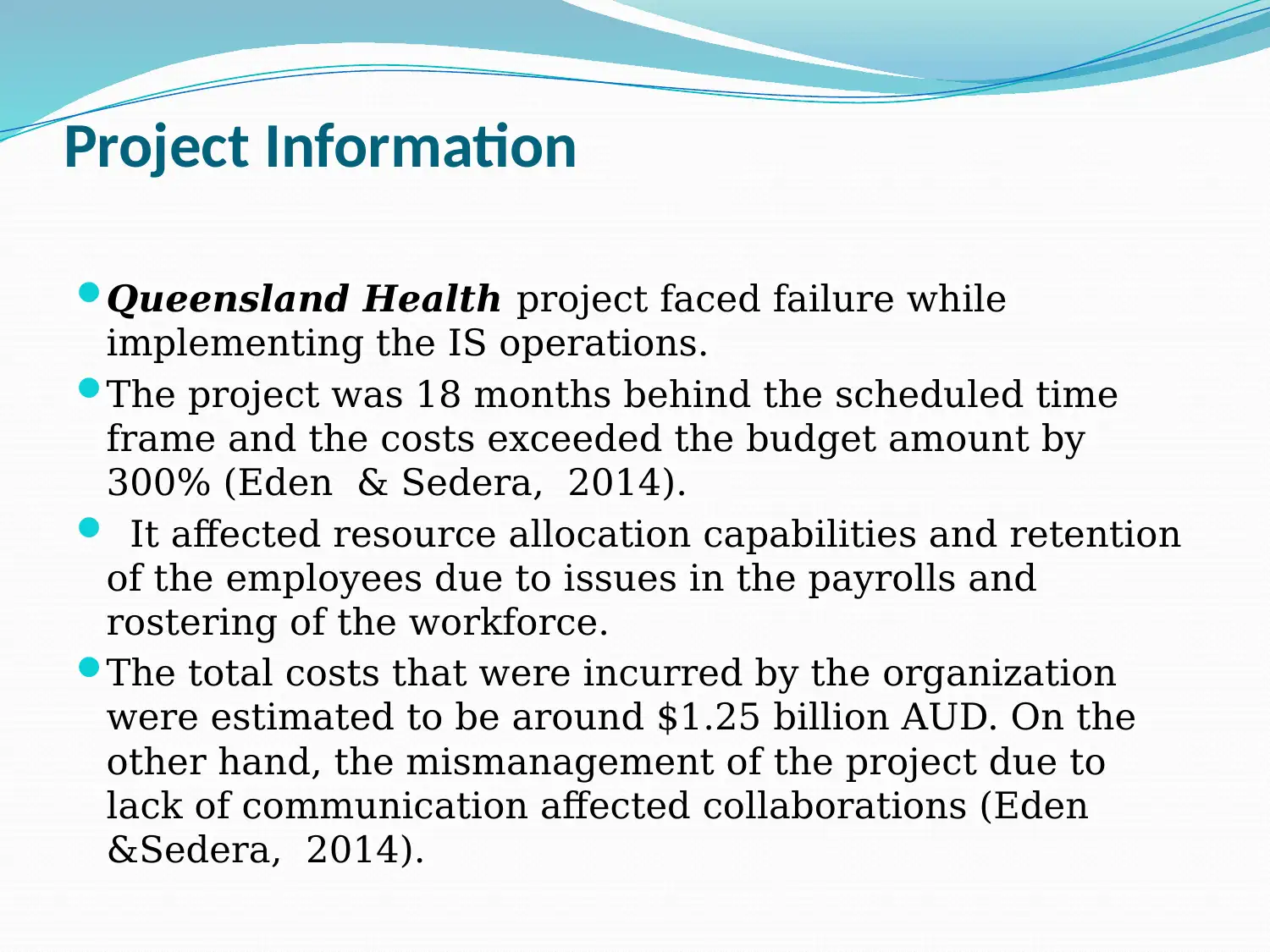
Project Information
Queensland Health project faced failure while
implementing the IS operations.
The project was 18 months behind the scheduled time
frame and the costs exceeded the budget amount by
300% (Eden & Sedera, 2014).
It affected resource allocation capabilities and retention
of the employees due to issues in the payrolls and
rostering of the workforce.
The total costs that were incurred by the organization
were estimated to be around $1.25 billion AUD. On the
other hand, the mismanagement of the project due to
lack of communication affected collaborations (Eden
&Sedera, 2014).
Queensland Health project faced failure while
implementing the IS operations.
The project was 18 months behind the scheduled time
frame and the costs exceeded the budget amount by
300% (Eden & Sedera, 2014).
It affected resource allocation capabilities and retention
of the employees due to issues in the payrolls and
rostering of the workforce.
The total costs that were incurred by the organization
were estimated to be around $1.25 billion AUD. On the
other hand, the mismanagement of the project due to
lack of communication affected collaborations (Eden
&Sedera, 2014).
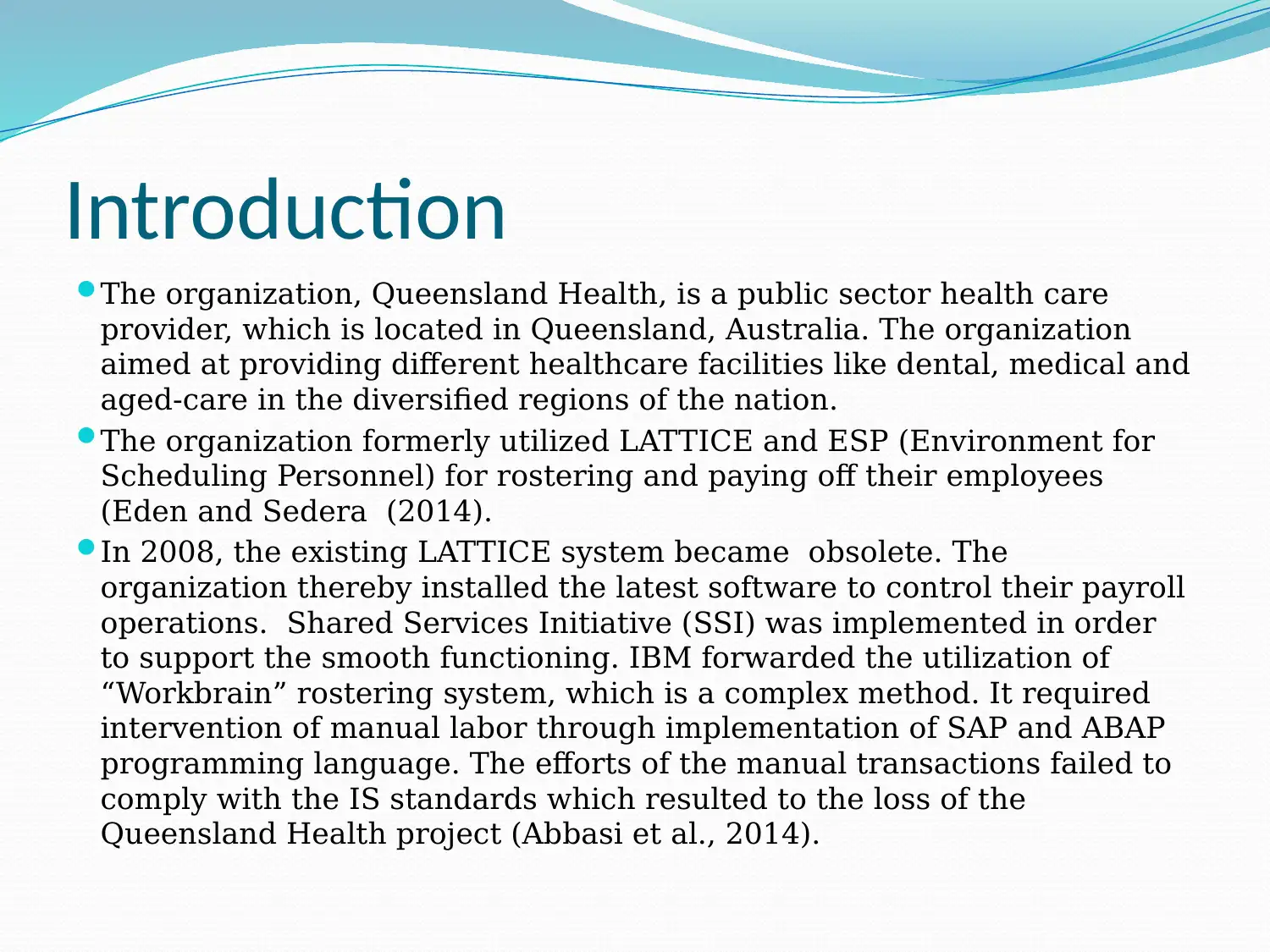
Introduction
The organization, Queensland Health, is a public sector health care
provider, which is located in Queensland, Australia. The organization
aimed at providing different healthcare facilities like dental, medical and
aged-care in the diversified regions of the nation.
The organization formerly utilized LATTICE and ESP (Environment for
Scheduling Personnel) for rostering and paying off their employees
(Eden and Sedera (2014).
In 2008, the existing LATTICE system became obsolete. The
organization thereby installed the latest software to control their payroll
operations. Shared Services Initiative (SSI) was implemented in order
to support the smooth functioning. IBM forwarded the utilization of
“Workbrain” rostering system, which is a complex method. It required
intervention of manual labor through implementation of SAP and ABAP
programming language. The efforts of the manual transactions failed to
comply with the IS standards which resulted to the loss of the
Queensland Health project (Abbasi et al., 2014).
The organization, Queensland Health, is a public sector health care
provider, which is located in Queensland, Australia. The organization
aimed at providing different healthcare facilities like dental, medical and
aged-care in the diversified regions of the nation.
The organization formerly utilized LATTICE and ESP (Environment for
Scheduling Personnel) for rostering and paying off their employees
(Eden and Sedera (2014).
In 2008, the existing LATTICE system became obsolete. The
organization thereby installed the latest software to control their payroll
operations. Shared Services Initiative (SSI) was implemented in order
to support the smooth functioning. IBM forwarded the utilization of
“Workbrain” rostering system, which is a complex method. It required
intervention of manual labor through implementation of SAP and ABAP
programming language. The efforts of the manual transactions failed to
comply with the IS standards which resulted to the loss of the
Queensland Health project (Abbasi et al., 2014).
⊘ This is a preview!⊘
Do you want full access?
Subscribe today to unlock all pages.

Trusted by 1+ million students worldwide

Major Issues
Complexity of the project design affected governance
The case of project failure of Queensland Health is related to the
complexity in the design of the project and lack of formalized
project management strategy.
Lack of formal approach in strategy formulation and vague goals
of the organization have affected the project outcomes.
Lack of efficient communication between the stakeholders
Lack of efficient communication within IBM, Queensland Health
and CorpTech resulted to gaps in coordination while operating
on the common goal of the business to implement SSI
Lack of discussion with the stakeholders on the objectives of the
venture would have helped the Queensland Health in managing
the project parameters more efficiently.
Complexity of the project design affected governance
The case of project failure of Queensland Health is related to the
complexity in the design of the project and lack of formalized
project management strategy.
Lack of formal approach in strategy formulation and vague goals
of the organization have affected the project outcomes.
Lack of efficient communication between the stakeholders
Lack of efficient communication within IBM, Queensland Health
and CorpTech resulted to gaps in coordination while operating
on the common goal of the business to implement SSI
Lack of discussion with the stakeholders on the objectives of the
venture would have helped the Queensland Health in managing
the project parameters more efficiently.
Paraphrase This Document
Need a fresh take? Get an instant paraphrase of this document with our AI Paraphraser

Control Systems
Queensland Health project utilized the
Waterfall methodology in order to control the
parameters of the project.
Steps included initiation of the project, the
design, implementation of the project, testing
the project and controlling the project in order
to maintain the efficacy of the project
parameters (Abbasi et al., 2014).
The rigid structure of the methodology affected
the initiator in planning and making changes in
the project parameters in the first two stages.
Queensland Health project utilized the
Waterfall methodology in order to control the
parameters of the project.
Steps included initiation of the project, the
design, implementation of the project, testing
the project and controlling the project in order
to maintain the efficacy of the project
parameters (Abbasi et al., 2014).
The rigid structure of the methodology affected
the initiator in planning and making changes in
the project parameters in the first two stages.
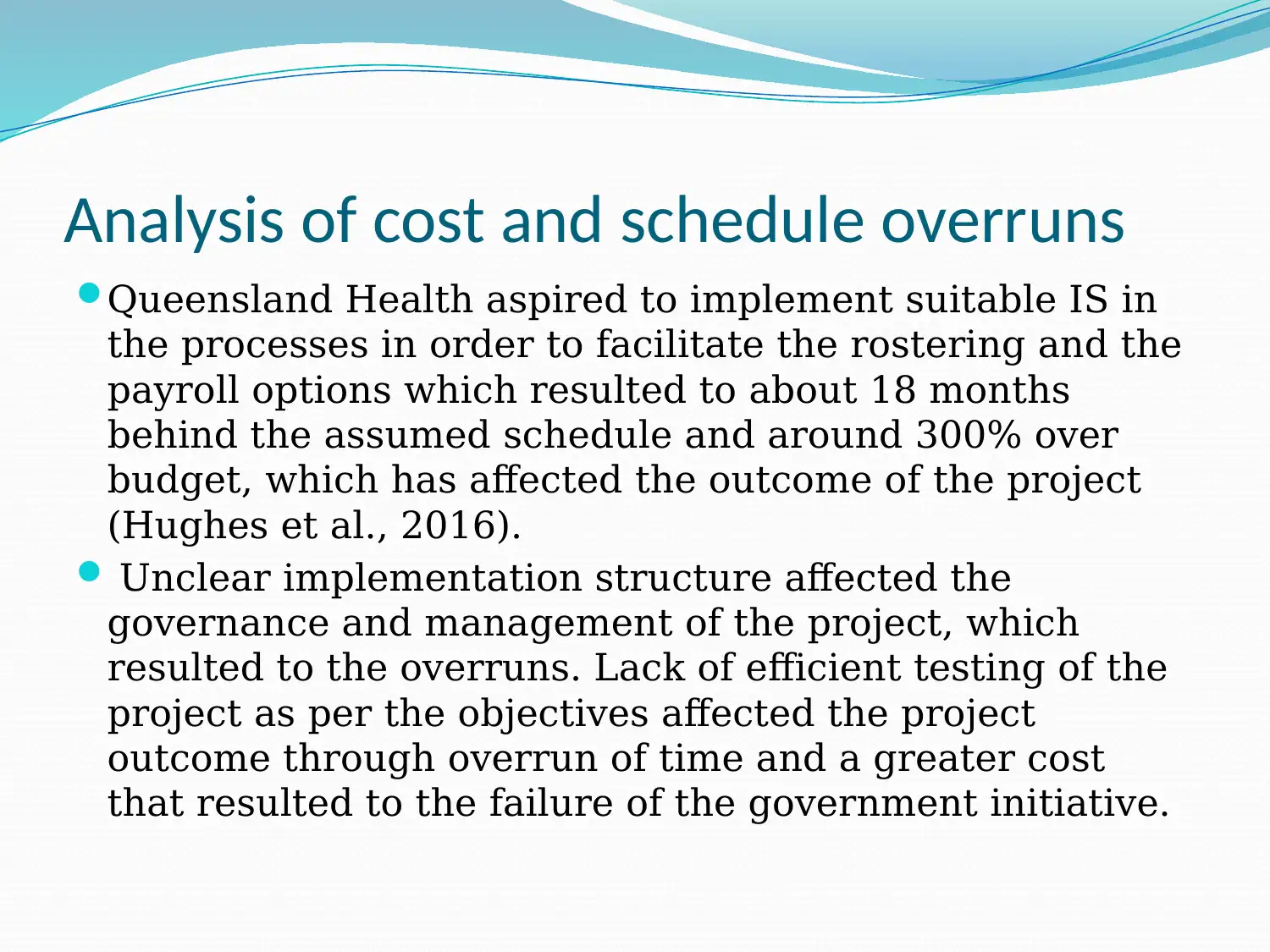
Analysis of cost and schedule overruns
Queensland Health aspired to implement suitable IS in
the processes in order to facilitate the rostering and the
payroll options which resulted to about 18 months
behind the assumed schedule and around 300% over
budget, which has affected the outcome of the project
(Hughes et al., 2016).
Unclear implementation structure affected the
governance and management of the project, which
resulted to the overruns. Lack of efficient testing of the
project as per the objectives affected the project
outcome through overrun of time and a greater cost
that resulted to the failure of the government initiative.
Queensland Health aspired to implement suitable IS in
the processes in order to facilitate the rostering and the
payroll options which resulted to about 18 months
behind the assumed schedule and around 300% over
budget, which has affected the outcome of the project
(Hughes et al., 2016).
Unclear implementation structure affected the
governance and management of the project, which
resulted to the overruns. Lack of efficient testing of the
project as per the objectives affected the project
outcome through overrun of time and a greater cost
that resulted to the failure of the government initiative.
⊘ This is a preview!⊘
Do you want full access?
Subscribe today to unlock all pages.

Trusted by 1+ million students worldwide

Analysis of the project execution team
IBM played a major role as the prime contractor as
it held the responsibility for implementing the
government mandated standardized software
solution in the government projects. Later it was
found that the organization was not responsible for
the implementation of the software solution due to
time and cost overruns.
On the other hand, CorpTech was held responsible
for managing the role of the prime contractor but
improper communication between the different
stakeholders affected the project outcome
dynamically.
IBM played a major role as the prime contractor as
it held the responsibility for implementing the
government mandated standardized software
solution in the government projects. Later it was
found that the organization was not responsible for
the implementation of the software solution due to
time and cost overruns.
On the other hand, CorpTech was held responsible
for managing the role of the prime contractor but
improper communication between the different
stakeholders affected the project outcome
dynamically.
Paraphrase This Document
Need a fresh take? Get an instant paraphrase of this document with our AI Paraphraser
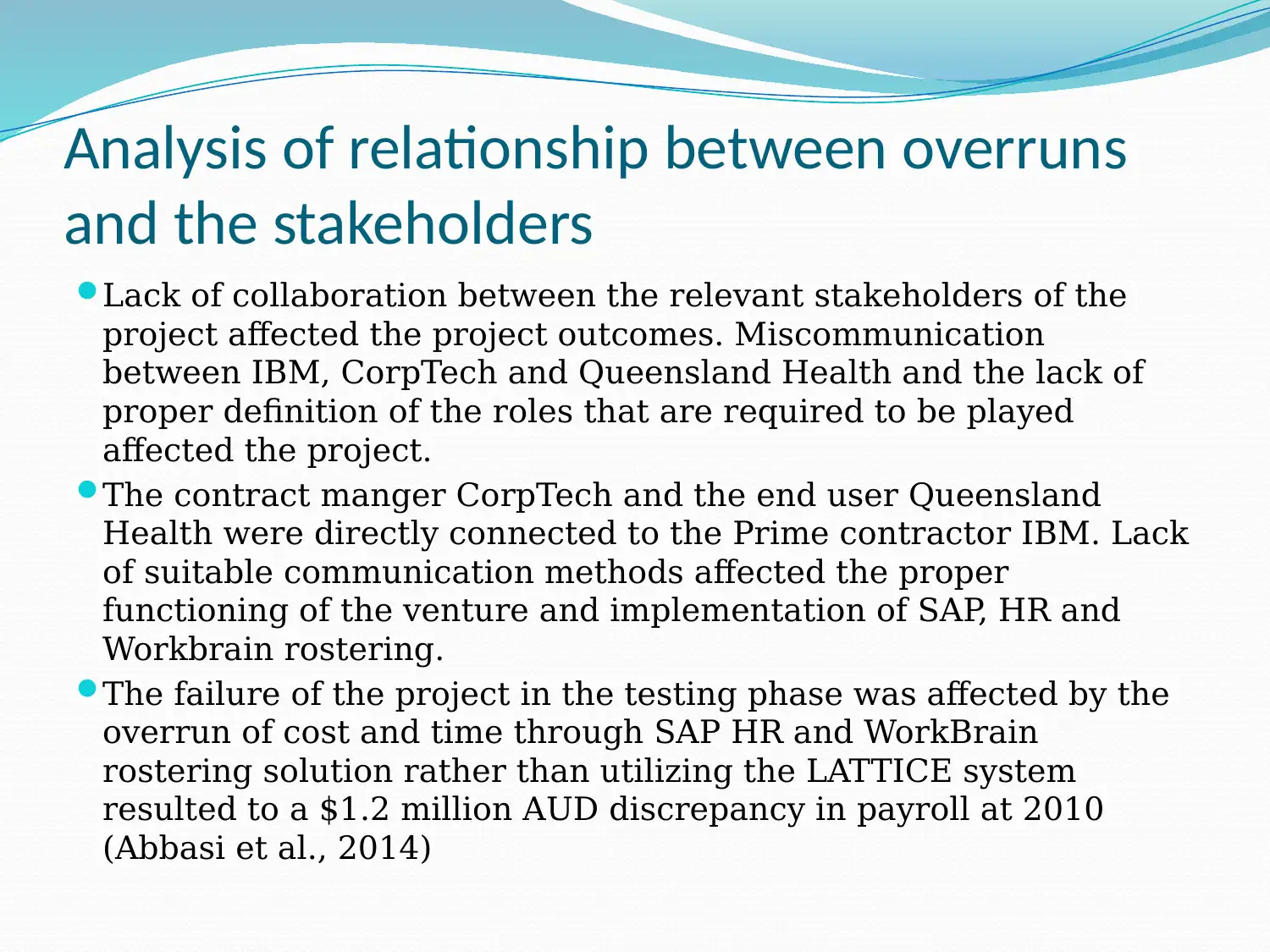
Analysis of relationship between overruns
and the stakeholders
Lack of collaboration between the relevant stakeholders of the
project affected the project outcomes. Miscommunication
between IBM, CorpTech and Queensland Health and the lack of
proper definition of the roles that are required to be played
affected the project.
The contract manger CorpTech and the end user Queensland
Health were directly connected to the Prime contractor IBM. Lack
of suitable communication methods affected the proper
functioning of the venture and implementation of SAP, HR and
Workbrain rostering.
The failure of the project in the testing phase was affected by the
overrun of cost and time through SAP HR and WorkBrain
rostering solution rather than utilizing the LATTICE system
resulted to a $1.2 million AUD discrepancy in payroll at 2010
(Abbasi et al., 2014)
and the stakeholders
Lack of collaboration between the relevant stakeholders of the
project affected the project outcomes. Miscommunication
between IBM, CorpTech and Queensland Health and the lack of
proper definition of the roles that are required to be played
affected the project.
The contract manger CorpTech and the end user Queensland
Health were directly connected to the Prime contractor IBM. Lack
of suitable communication methods affected the proper
functioning of the venture and implementation of SAP, HR and
Workbrain rostering.
The failure of the project in the testing phase was affected by the
overrun of cost and time through SAP HR and WorkBrain
rostering solution rather than utilizing the LATTICE system
resulted to a $1.2 million AUD discrepancy in payroll at 2010
(Abbasi et al., 2014)
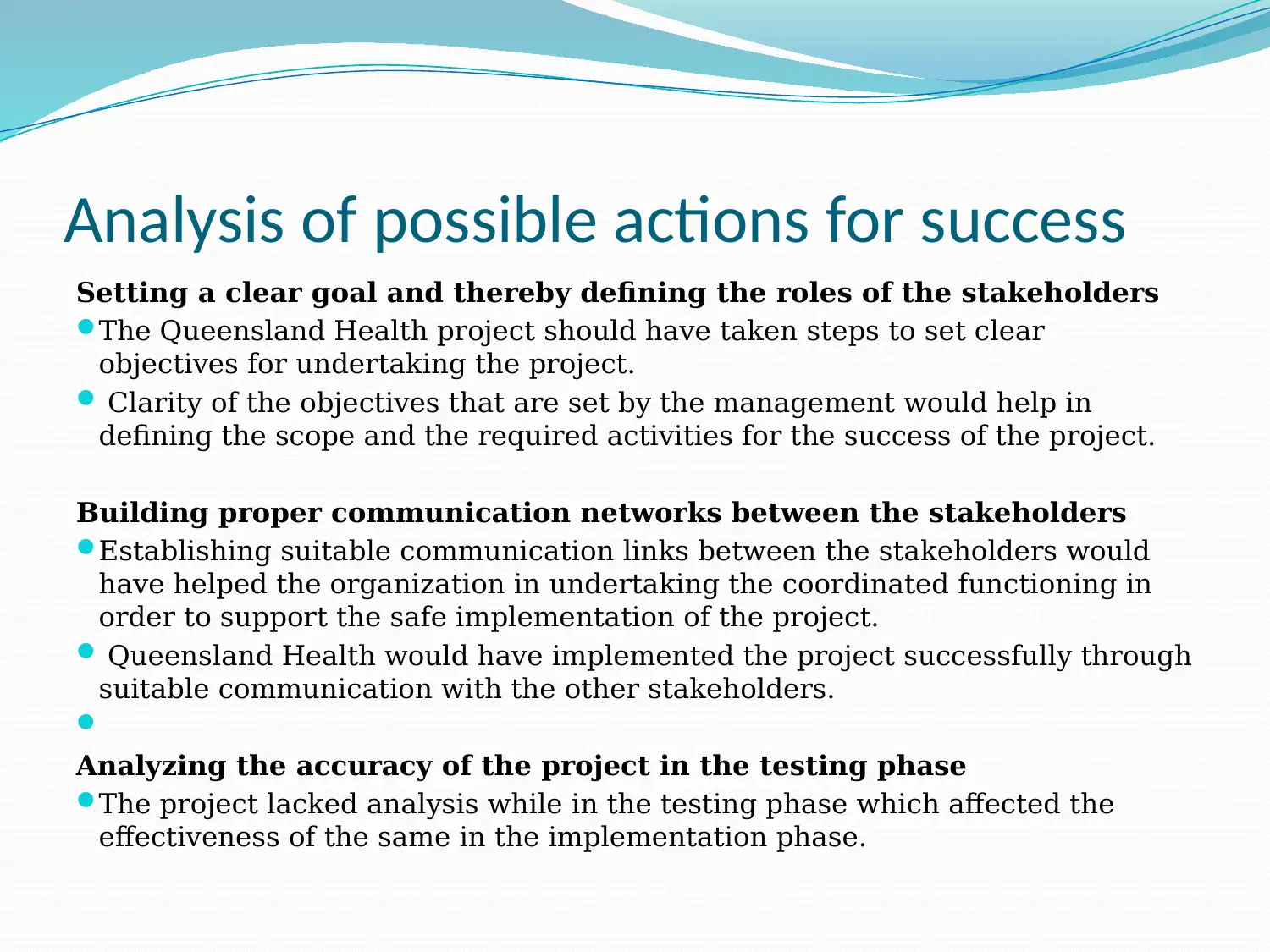
Analysis of possible actions for success
Setting a clear goal and thereby defining the roles of the stakeholders
The Queensland Health project should have taken steps to set clear
objectives for undertaking the project.
Clarity of the objectives that are set by the management would help in
defining the scope and the required activities for the success of the project.
Building proper communication networks between the stakeholders
Establishing suitable communication links between the stakeholders would
have helped the organization in undertaking the coordinated functioning in
order to support the safe implementation of the project.
Queensland Health would have implemented the project successfully through
suitable communication with the other stakeholders.
Analyzing the accuracy of the project in the testing phase
The project lacked analysis while in the testing phase which affected the
effectiveness of the same in the implementation phase.
Setting a clear goal and thereby defining the roles of the stakeholders
The Queensland Health project should have taken steps to set clear
objectives for undertaking the project.
Clarity of the objectives that are set by the management would help in
defining the scope and the required activities for the success of the project.
Building proper communication networks between the stakeholders
Establishing suitable communication links between the stakeholders would
have helped the organization in undertaking the coordinated functioning in
order to support the safe implementation of the project.
Queensland Health would have implemented the project successfully through
suitable communication with the other stakeholders.
Analyzing the accuracy of the project in the testing phase
The project lacked analysis while in the testing phase which affected the
effectiveness of the same in the implementation phase.
⊘ This is a preview!⊘
Do you want full access?
Subscribe today to unlock all pages.

Trusted by 1+ million students worldwide
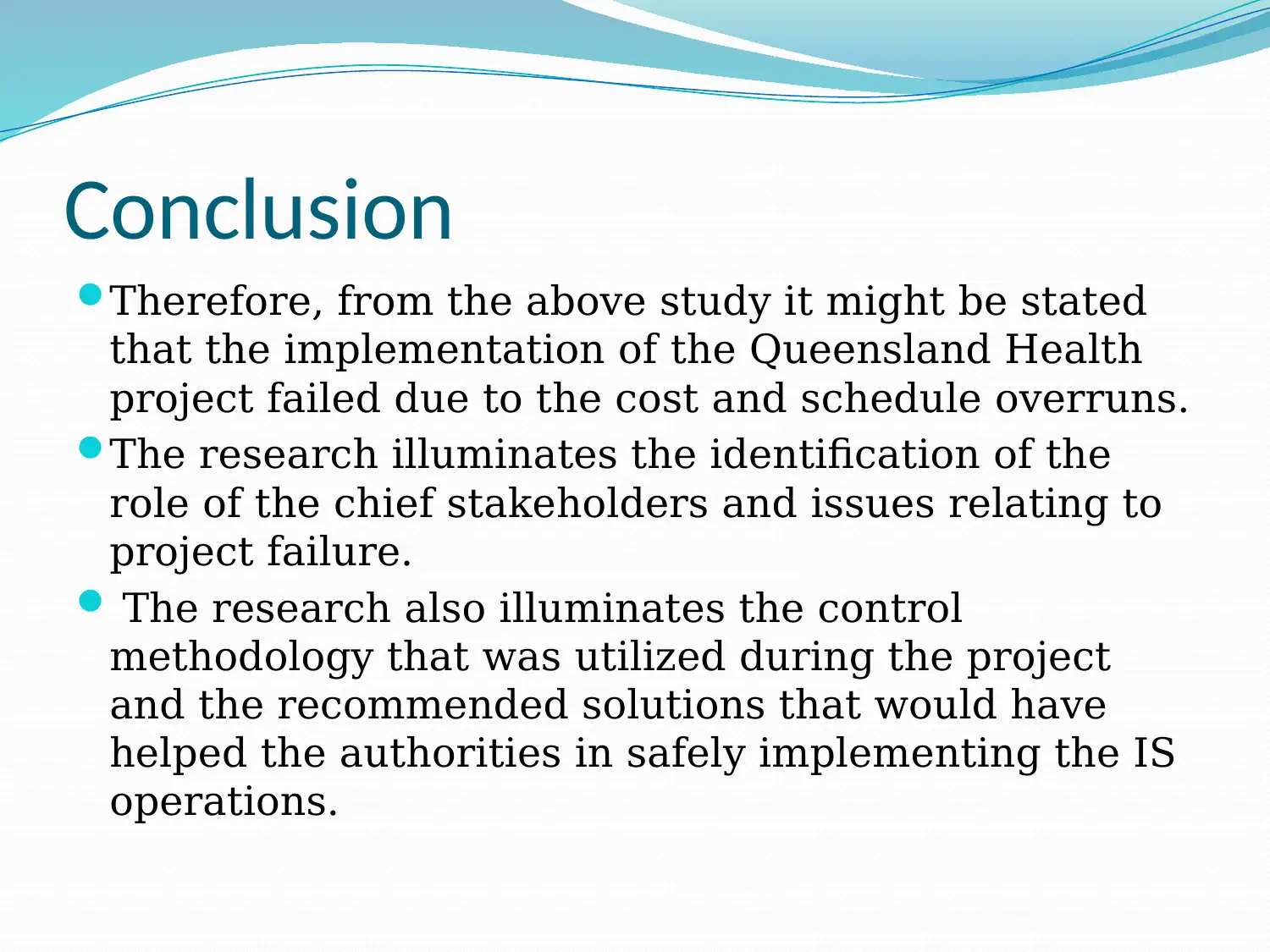
Conclusion
Therefore, from the above study it might be stated
that the implementation of the Queensland Health
project failed due to the cost and schedule overruns.
The research illuminates the identification of the
role of the chief stakeholders and issues relating to
project failure.
The research also illuminates the control
methodology that was utilized during the project
and the recommended solutions that would have
helped the authorities in safely implementing the IS
operations.
Therefore, from the above study it might be stated
that the implementation of the Queensland Health
project failed due to the cost and schedule overruns.
The research illuminates the identification of the
role of the chief stakeholders and issues relating to
project failure.
The research also illuminates the control
methodology that was utilized during the project
and the recommended solutions that would have
helped the authorities in safely implementing the IS
operations.
Paraphrase This Document
Need a fresh take? Get an instant paraphrase of this document with our AI Paraphraser

References
Abbasi, N., Wajid, I., Iqbal, Z., & Zafar, F. (2014). Project failure
case studies and suggestion. International Journal of
Computer Applications, 86(6).
Eden, R., & Sedera, D. (2014). The largest admitted IT project
failure in the Southern Hemisphere: a teaching case.
In Proceedings of the 35th International Conference on
Information Systems: Building a Better World Through
Information Systems. AISeL.
Hughes, D. L., Dwivedi, Y. K., Rana, N. P., & Simintiras, A. C.
(2016). Information systems project failure–analysis of causal
links using interpretive structural modelling. Production
Planning & Control, 27(16), 1313-1333.
Abbasi, N., Wajid, I., Iqbal, Z., & Zafar, F. (2014). Project failure
case studies and suggestion. International Journal of
Computer Applications, 86(6).
Eden, R., & Sedera, D. (2014). The largest admitted IT project
failure in the Southern Hemisphere: a teaching case.
In Proceedings of the 35th International Conference on
Information Systems: Building a Better World Through
Information Systems. AISeL.
Hughes, D. L., Dwivedi, Y. K., Rana, N. P., & Simintiras, A. C.
(2016). Information systems project failure–analysis of causal
links using interpretive structural modelling. Production
Planning & Control, 27(16), 1313-1333.

⊘ This is a preview!⊘
Do you want full access?
Subscribe today to unlock all pages.

Trusted by 1+ million students worldwide
1 out of 12
Related Documents
Your All-in-One AI-Powered Toolkit for Academic Success.
+13062052269
info@desklib.com
Available 24*7 on WhatsApp / Email
![[object Object]](/_next/static/media/star-bottom.7253800d.svg)
Unlock your academic potential
Copyright © 2020–2025 A2Z Services. All Rights Reserved. Developed and managed by ZUCOL.




